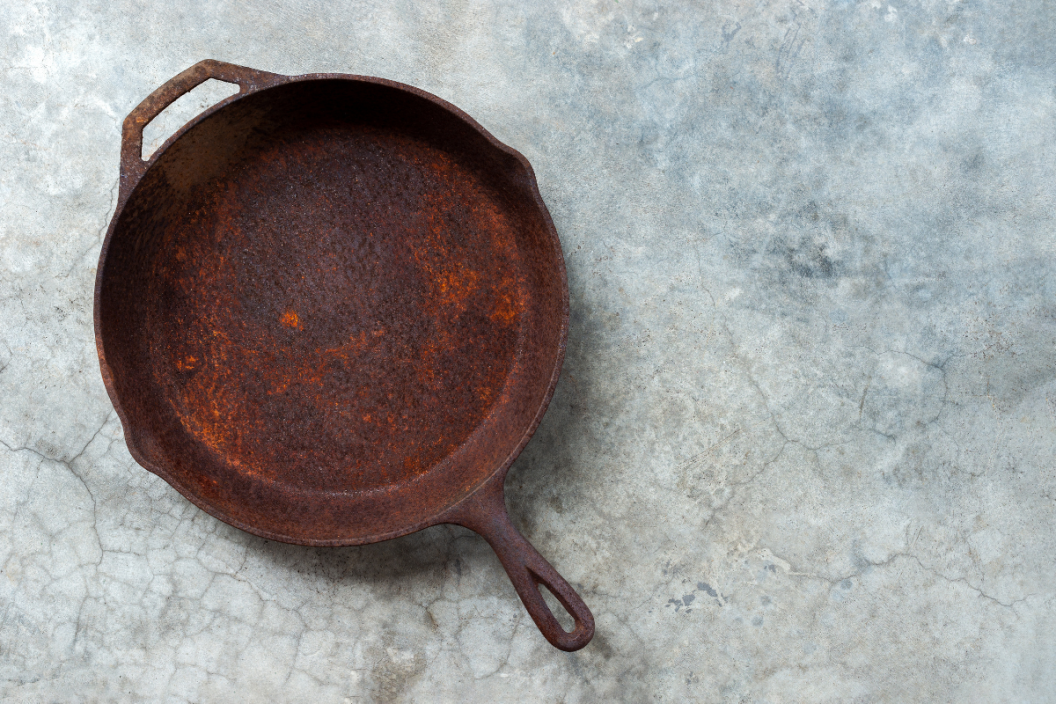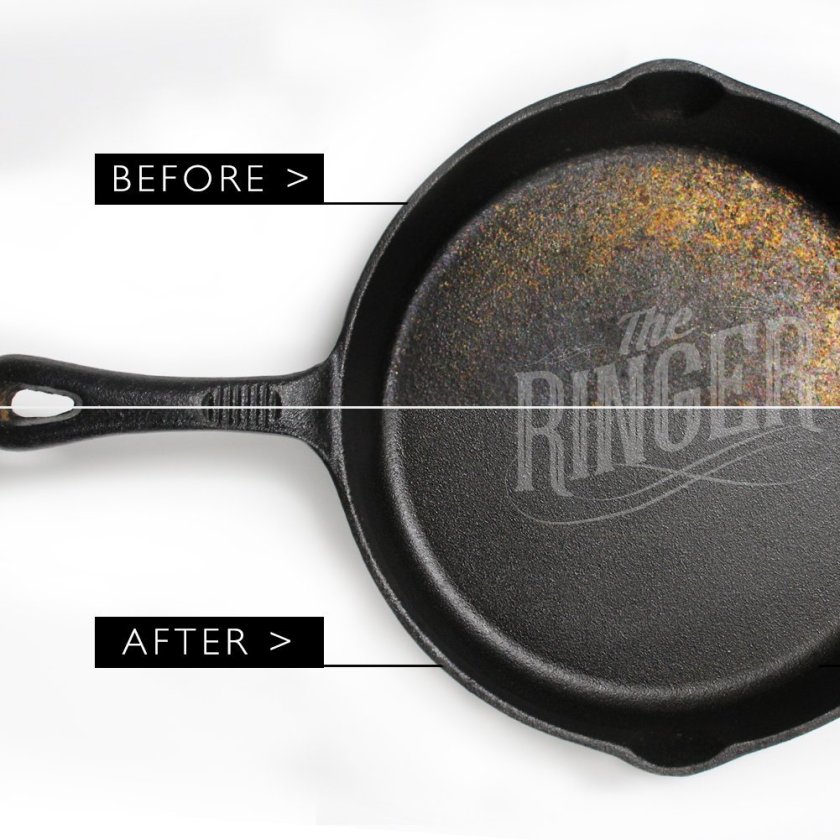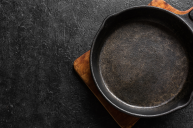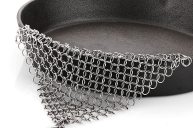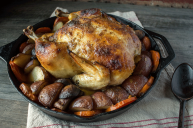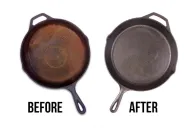From time to time, our beloved cast iron skillet gets neglected. Failure to re-season and clean properly can lead to one rusty cast iron skillet - and nobody wants to cook with rust. Before you decide to toss out the skillet, there is still hope to remove rust. From the people who know cast iron cookware best, Lodge Cast Iron show us how we can restore a rusty cast iron skillet to spanking brand new.
Unlike non-stick pans, cast iron was meant to last forever - even when rust takes hold. For those of you with a rusty skillet, Lodge Cast Iron recommends a good scrub, wash, dry, oil, and bake. With a good sprucing up using this five-step method, you can salvage your skillet and get back to cooking.
Look at that entire skillet! To clean off stuck-on food, which isn't covered in this video, simply pour a tablespoon of kosher salt into the pan and scrub the salt into the pan with a sponge. Wipe out the salt, and rinse. If it's truly stuck, feel free to let it soak briefly so the warm water and mild dish soap can lift away any stubborn bits on the cooking surface.
Some elbow grease and a little bit of heat were all the skillet needed. Now, I know there is much debate on the soap part. Some people swear it will ruin a seasoned skillet, while others choose to use just a touch. But if the makers of cast iron say a little bit is okay for cast iron care, then it can't be that bad, right?
Either way, next time you fail to clean your skillet after a long camping trip - I swear it wasn't my fault - try this method. Simply round up your vegetable oil or canola oil, (these cooking oils work best) grab a few clean paper towels, and step away from the steel wool. An abrasive sponge will only scratch up the pan more.
It's important to note that you can choose to begin the drying process for the skillet on low heat on a stovetop burner, though a truly clean cast iron will finish upside down at 350 degrees Fahrenheit in the oven so no more rust forms. Store in a dry place overnight to ensure it's completely dry.
Make sure to line the bottom of the oven in aluminum foil though. Otherwise, you'll have a whole new mess to deal with. Don't fear the cast-iron pan in your kitchen! It's your most reliable piece of cookware.
How To Restore a Rusty Cast Iron Skillet
- Using steel wool or scrub pad, remove all the rust and gunk from the rusty pan. This is the only time you use a scouring pad!
- Wash the pan with water and dish soap then dry it immediately with paper towels.
- Now comes the reseasoning part. Coat the pan in a thin layer of vegetable oil, making sure to use a little amount on the bottom and handle.
- Place the old cast iron pan upside down with a foil-lined pan on the bottom rack to catch drippings. Heat for one hour.
- Turn off the heat, let the cast iron cool, then get to cooking!
The next time you consider using white vinegar, soapy water, or scouring pads, check out this handy cast iron skillet tool that works on models from Lodge to Cuisinart. The Ringer is a patented chainmail scrubber that makes cleaning your cast iron so easy.
I swear by it at home, and I have actually restored a thrift store cast iron skillet using the Ringer and the method in the video from Lodge above. Win-win!
How to Care For Your Cast Iron Skillet
Once you have your cast iron skillet restored to tip-top condition, the last thing you want is for it to quickly collect rust again. This is why it's important to learn how to care for your cast iron skillet, maintaining its condition so that you'll be able to use it efficiently for years to come. One the biggest debates in the world of cast iron skillets is whether to clean it with soap or not. Those who stand by the no-soap approach have very strong feelings and firmly stand by their soapless cleaning methods.
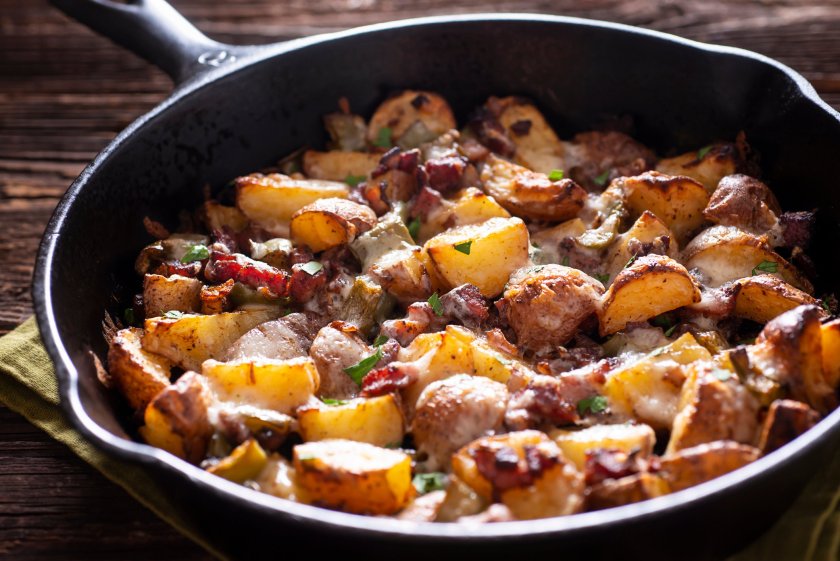
Getty Images/rudisill
However, it's actually fine to use soap to clean your pan, since the seasoning on it is far too strong to be stripped away with something as simple as soap. The
seasoning is the tough, protective layer that coast the pan, crated by covering it in oil and heating it, and it's sturdy enough to stay on your pan through a simple soapy wash. The best way to maintain the condition of your cast iron skillet is to use it as often as possible, especially for dishes that include fat and oil. Each time you use oil on your pan, the seasoning gets another layer and is reinforced.
After using it, it's important to clean your pan so that chunks of food don't get stuck on it. Clean your dirty cast iron skillet with a sponge and some dish soap, and clean it like you would any other pan. Avoid abrasive materials like steel wood, and stick to the classic soft sponge you wash your plates with. Dry the pan thoroughly every time you wash it, and then put it back in the cabinet or on the hook where it belongs! Every once in a while, it's a good idea to return to steps 3-5 for restoring your cast iron, just to make sure that the coating on your pan remains thick and durable.
Now that your cast iron skillet is as good as new, here are 15 skillet bread recipes to make with it!
Editor's Note: Products featured on Wide Open Country are independently selected by our editors. However, when you buy something through our links, we may earn a commission.
